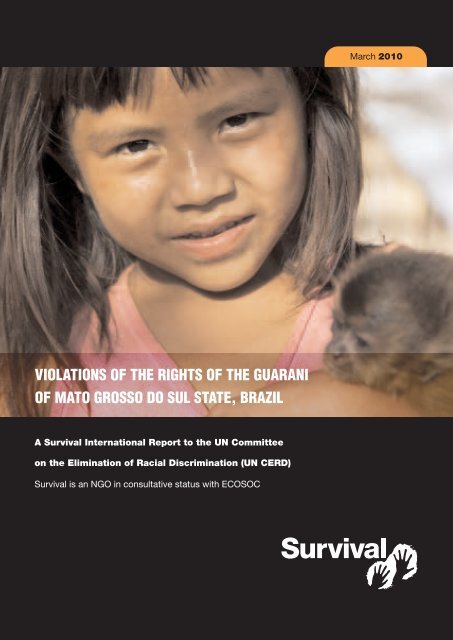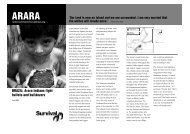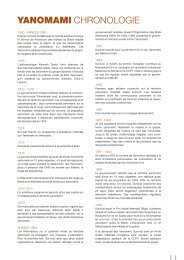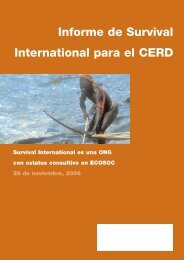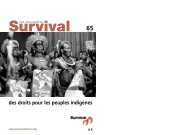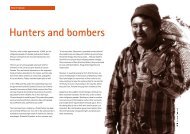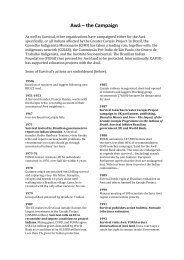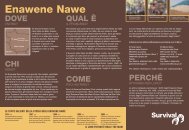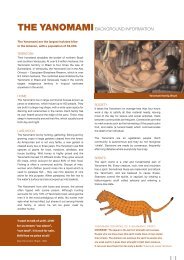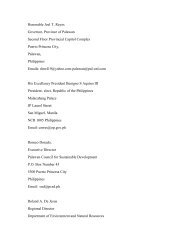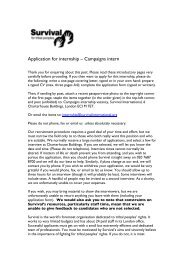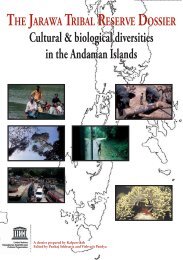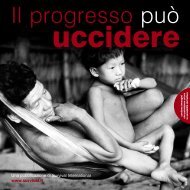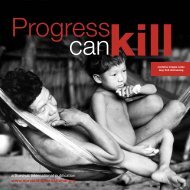violations of the rights of the guarani of mato grosso do sul state, brazil
violations of the rights of the guarani of mato grosso do sul state, brazil
violations of the rights of the guarani of mato grosso do sul state, brazil
You also want an ePaper? Increase the reach of your titles
YUMPU automatically turns print PDFs into web optimized ePapers that Google loves.
March 2010VIOLATIONS OF THE RIGHTS OF THE GUARANIOF MATO GROSSO DO SUL STATE, BRAZILA Survival International Report to <strong>the</strong> UN Committeeon <strong>the</strong> Elimination <strong>of</strong> Racial Discrimination (UN CERD)Survival is an NGO in con<strong>sul</strong>tative status with ECOSOC
‘If <strong>the</strong>y <strong>do</strong>n’t <strong>do</strong>something for us,it’s better to putout <strong>the</strong> sun.’Amilton Lopes, Guarani Kaiowá 1A SURVIVAL INTERNATIONAL REPORT SUBMITTED TO CERD UNDER ITS URGENT PROCEDURE SYSTEMINTRODUCTIONThe lives and livelihood <strong>of</strong> <strong>the</strong> Guarani Indiansin <strong>the</strong> <strong>state</strong> <strong>of</strong> Mato Grosso <strong>do</strong> Sul in Brazil arebeing seriously damaged by <strong>the</strong> denial <strong>of</strong> land<strong>rights</strong>. The occupation and <strong>the</strong>ft <strong>of</strong> <strong>the</strong>ir landby industries and governmental colonisationschemes has re<strong>sul</strong>ted in a desperate andexplosive situation where <strong>the</strong> Guarani sufferfrom unfair imprisonment, exploitation,discrimination, malnutrition, intimidation,violence and assassination, and an extremelyhigh suicide rate.Following her visit to Brazil in November 2009,United Nations High Commissioner for HumanRights Navi Pillay <strong>state</strong>d that, for <strong>the</strong> most part,Brazil’s indigenous people ‘are not benefitingfrom <strong>the</strong> country’s impressive economic progress,and are being held back by discrimination andindifference, chased out <strong>of</strong> <strong>the</strong>ir lands and int<strong>of</strong>orced labour’. 2This situation is particularly serious amongst<strong>the</strong> Guarani who, following decades <strong>of</strong> losing<strong>the</strong>ir ancestral lands to sugar cane, soya andtea planters, cattle ranchers, and governmentcolonisation schemes, face one <strong>of</strong> <strong>the</strong> worstsituations <strong>of</strong> all indigenous peoples in Brazil,if not <strong>the</strong> Americas. Pr<strong>of</strong> James Anaya, UNSpecial Rapporteur on <strong>the</strong> situation <strong>of</strong> human<strong>rights</strong> and fundamental free<strong>do</strong>ms <strong>of</strong> indigenouspeople, visited Brazil in August 2008. With regardto non-indigenous settlement <strong>of</strong> indigenous land,he singles out <strong>the</strong> appalling situation in MatoGrosso <strong>do</strong> Sul, stating in paragraph 73 <strong>of</strong> hisReport on <strong>the</strong> situation <strong>of</strong> indigenous peoplesin Brazil that:‘Tensions between indigenous peoplesand non-indigenous occupants have beenespecially acute in <strong>the</strong> <strong>state</strong> <strong>of</strong> Mato Grosso<strong>do</strong> Sul, where indigenous peoples suffer froma severe lack <strong>of</strong> access to <strong>the</strong>ir traditionallands, extreme poverty and related socialills; giving rise to a pattern <strong>of</strong> violence that ismarked by numerous murders <strong>of</strong> indigenousindividuals as well as by criminal prosecution<strong>of</strong> indigenous individuals for acts <strong>of</strong> protest’. 3After her visit to Mato Grosso <strong>do</strong> Sul as part <strong>of</strong><strong>the</strong> Commission <strong>of</strong> Human Rights and ParticipatoryLegislation in October 2009, Brazilian senator andformer environment minister Marina Silva declaredthat <strong>the</strong> problems faced by <strong>the</strong> indigenouspopulation ‘are <strong>of</strong> a very grave nature’, and that<strong>the</strong> 45,000 Indians <strong>of</strong> Mato Grosso <strong>do</strong> Sul facea true ‘social apar<strong>the</strong>id’, owing to <strong>the</strong>ir inabilityto exercise <strong>the</strong>ir <strong>rights</strong>. 4In his report about <strong>the</strong> Guarani Kaiowá <strong>of</strong> MatoGrosso <strong>do</strong> Sul, anthropologist Marcos Homero1
Ferreira Lima <strong>of</strong> <strong>the</strong> Public Prosecutor’s Office <strong>of</strong>Doura<strong>do</strong>s, Mato Grosso <strong>do</strong> Sul, <strong>the</strong> body chargedwith protecting and enforcing indigenous <strong>rights</strong>,<strong>state</strong>s that:‘The situation <strong>of</strong> <strong>the</strong> Guarani Kaiowá <strong>of</strong> <strong>the</strong>Curral <strong>do</strong> Arame requires an immediate andurgent solution. It is not an exaggeration tospeak <strong>of</strong> genocide, since <strong>the</strong> series <strong>of</strong> eventsand actions committed against this groupsince <strong>the</strong> end <strong>of</strong> <strong>the</strong> 1990s has contributedto subjecting its members to conditionspreventing <strong>the</strong>ir physical, culturaland spiritual existence. Children, youngpeople, adults and <strong>the</strong> elderly are subjectedto degrading experiences which directly harm<strong>the</strong>ir human dignity.The way <strong>of</strong> life imposed on <strong>the</strong> Guarani Kaiowáreveals how <strong>the</strong> white people see <strong>the</strong> Indians.Prejudice, indifference, mistreatment, nonconsideration<strong>of</strong> <strong>the</strong>ir <strong>rights</strong> to <strong>the</strong> land, to life,to dignity are all evident. They are living in asituation analogous to that <strong>of</strong> a refugee camp.It is as if <strong>the</strong>y were strangers in <strong>the</strong>ir owncountry. It is as if <strong>the</strong> ‘whites’ have gone to warwith <strong>the</strong> Indians and <strong>the</strong> latter are left with <strong>the</strong>thin strip <strong>of</strong> land separating a ranch from <strong>the</strong>side <strong>of</strong> a road.’ 5In May 2002, Deputy Orlan<strong>do</strong> Fantazzini,President <strong>of</strong> Brazil’s Commission on HumanRights, made an urgent request for <strong>the</strong>government to protect <strong>the</strong> Guarani. In relationto malnutrition and suicide amongst <strong>the</strong> Guarani,he <strong>state</strong>d that ‘<strong>the</strong> Guarani Kaiowá are losing,toge<strong>the</strong>r with <strong>the</strong>ir ancestral lands, <strong>the</strong>ir hope for<strong>the</strong> future and <strong>the</strong>ir faith in <strong>the</strong> State and its laws…<strong>the</strong> efficient demarcation <strong>of</strong> <strong>the</strong> Guarani Kaiowálands, amongst o<strong>the</strong>r public policies, arenecessary in order to create conditions where<strong>the</strong> Guarani can exercise <strong>the</strong>ir fundamental <strong>rights</strong>,such as <strong>the</strong> right to food. If this is not <strong>do</strong>ne, <strong>the</strong>State could be held responsible and be punishedby <strong>the</strong> international courts <strong>of</strong> Human Rights’. 7This Survival International report to CERDexamines <strong>the</strong> human <strong>rights</strong> abuses suffered by<strong>the</strong> Guarani <strong>of</strong> Mato Grosso <strong>do</strong> Sul <strong>state</strong>, Brazil.It concentrates on this particular <strong>state</strong> as SurvivalInternational has worked with <strong>the</strong>se Guarani formany years. We acknowledge that <strong>the</strong> Guarani<strong>of</strong> <strong>the</strong> Brazilian <strong>state</strong>s <strong>of</strong> Rio de Janeiro, SãoPaulo, Santa Catarina, Rio Grande <strong>do</strong> Sul,Espírito Santo and Paraná, and those livingin Bolivia, Paraguay and Argentina also faceserious problems and <strong>the</strong>ir situation mustalso be addressed.Dr. Marcio Meira, President <strong>of</strong> Brazil’s IndianAffairs Agency (Fundação Nacional <strong>do</strong> Indio-FUNAI) <strong>state</strong>d that Brazil is being observedinternationally regarding <strong>the</strong> situation <strong>of</strong> <strong>the</strong>Guarani and that it is unacceptable that <strong>the</strong>tribe live in such ‘precarious conditions’.‘It is a serious conflict and it requiresmuch attention’, he said. ‘Several indigenouspeople have been assassinated in <strong>the</strong> area,and <strong>the</strong>y suffer from violence and prejudice.It is an area in which economic andagroindustrial expansion has been particularlystrong in recent years. We <strong>do</strong> not want <strong>the</strong>indigenous peoples to be guaranteed <strong>the</strong>ir<strong>rights</strong> only through blood and death’. 6‘The situation <strong>of</strong> <strong>the</strong> Guarani Kaiowá <strong>of</strong> <strong>the</strong>Curral <strong>do</strong> Arame requires an immediate andurgent solution. It is not an exaggerationto speak <strong>of</strong> genocide...’2
2. THE GUARANI AND THEIR LAND‘This here is my life. My soul. If you takeme away from this, you take my life.’Marcos Veron 8The Guarani Indians in Brazil are divided into threegroups: Mbyá, Kaiowá and Ñandeva. The Kaiowáand <strong>the</strong> Ñandeva live in <strong>the</strong> <strong>state</strong> <strong>of</strong> Mato Grosso<strong>do</strong> Sul, on <strong>the</strong> border with Paraguay.The Guarani live in extended family groups andeach has its own land called tekohá which refersto <strong>the</strong> whole space occupied by natural resources:land, rivers, forests and gardens which are integralto sustaining <strong>the</strong>ir way <strong>of</strong> life. 9 Rosalino OrtizÑandeva told Survival ‘Land is sacred for usKaiowá. Land is <strong>the</strong> essence <strong>of</strong> Kaiowá life forus. Land is <strong>the</strong> structure <strong>of</strong> life for us Guaraniindigenous people’. 10Land is a vital reference point for <strong>the</strong> Guarani,not just in its physical but also in its mysticaldimension, which structures <strong>the</strong> whole <strong>of</strong> Guaranisociety around <strong>the</strong> tekohá. Indeed, <strong>the</strong> wordKaiowá means ‘people <strong>of</strong> <strong>the</strong> forest’. The Guaranineed not just any land, but that on which <strong>the</strong>irancestors built up <strong>the</strong> base for constructing <strong>the</strong>‘Land without Evil’.Before <strong>the</strong> arrival <strong>of</strong> <strong>the</strong> Europeans in <strong>the</strong> sixteenthcentury, <strong>the</strong> Guarani occupied a vast region in<strong>the</strong> south-centre and south-east <strong>of</strong> South America.There were an estimated 1,500,000 Indians ina territory <strong>of</strong> about 350,000 square kilometres. 11The Guarani population in Brazil now numbersapproximately 43,000 12 . Following decades <strong>of</strong>violent invasions by cattle ranchers, and <strong>the</strong>more recent occupation <strong>of</strong> Guarani lands bysugar cane companies, nearly all <strong>of</strong> <strong>the</strong>ir landhas been stolen. Waves <strong>of</strong> deforestation haveconverted <strong>the</strong> once-fertile Guarani homelandinto a vast network <strong>of</strong> cattle ranches, soyafarms, and sugar cane plantations for Brazil’sbi<strong>of</strong>uels market.Paulito, a Guarani shaman, summed uphis people’s situation in an interview withSurvival in 1998: ‘Our religion and way <strong>of</strong> lifeare under attack. We <strong>do</strong> not have enough landto continue our old ways in <strong>the</strong> correct way.In <strong>the</strong> past this was a very big Indian area.I got married when I was a young man, andI had 25 hectares <strong>of</strong> land for my garden, andthis land fed my family and parents. We didn’tknow about sugar and salt <strong>the</strong>n. For sugar weused <strong>the</strong> honey we collected from bees. Wehad our chicha (fermented corn drink) and wehad lots <strong>of</strong> fish. I would perform a fish prayerand I would see <strong>the</strong> fish fatten over time. ThenI would put a line in <strong>the</strong> water and take two orthree, just what I needed. There were alwaysplenty <strong>of</strong> fish in those days. There were nowhite people <strong>the</strong>n. And <strong>the</strong>n <strong>the</strong> white peoplestarted to come in. We saw <strong>the</strong>m cut <strong>do</strong>wn <strong>the</strong>forest and make gardens for <strong>the</strong>mselves. Inthose days my people lived in four largecommunal houses. I always remember oneold man said, ‘The whites – <strong>the</strong>y’re going t<strong>of</strong>inish us <strong>of</strong>f. They’re going to finish <strong>of</strong>f ourhouses, finish our fish, even our crops. An<strong>do</strong>nce all our forest is gone, we as a peoplewill be finished. It’s all going to change an<strong>do</strong>ur land will become very small.’ And youknow, that man, all those years ago,calculated absolutely right.’ 13Many <strong>of</strong> <strong>the</strong> injustices <strong>the</strong> Guarani suffer arein breach <strong>of</strong> <strong>the</strong> Brazilian Constitution, Brazil’sIndian Statute, <strong>the</strong> UN Declaration on <strong>the</strong> Rights<strong>of</strong> Indigenous Peoples, <strong>the</strong> InternationalConvention on <strong>the</strong> Elimination <strong>of</strong> All Forms<strong>of</strong> Racial Discrimination, and <strong>the</strong> InternationalLabour Organisation’s (ILO) Convention 169,to which Brazil is a signatory.3
Many Guarani are now forcedto live by <strong>the</strong> side <strong>of</strong> <strong>the</strong> road.The forced evictions <strong>of</strong> <strong>the</strong> Guarani from <strong>the</strong>irland are in breach <strong>of</strong>:1. Article 231 <strong>of</strong> Brazil’s Constitution which <strong>state</strong>sthat ‘Indians shall have <strong>the</strong>ir social organization,customs, languages, creeds and traditionsrecognized, as well as <strong>the</strong>ir original <strong>rights</strong> to<strong>the</strong> lands <strong>the</strong>y traditionally occupy, it beingincumbent upon <strong>the</strong> Union to demarcate <strong>the</strong>m,protect and ensure respect for all <strong>of</strong> <strong>the</strong>irproperty… The removal <strong>of</strong> Indian groups from<strong>the</strong>ir lands is forbidden, except ad referendum<strong>of</strong> <strong>the</strong> National Congress, in case <strong>of</strong> a catastropheor an epidemic which represents a risk to <strong>the</strong>irpopulation, or in <strong>the</strong> interest <strong>of</strong> <strong>the</strong> sovereignty<strong>of</strong> <strong>the</strong> country, after decision by <strong>the</strong> NationalCongress, it being guaranteed that, under anycircumstances, <strong>the</strong> return shall be immediateas soon as <strong>the</strong> risk ceases’,concerned over <strong>the</strong> lands which <strong>the</strong>y traditionallyoccupy shall be recognised’ and ‘Governmentsshall take steps as necessary to identify <strong>the</strong> landswhich <strong>the</strong> peoples concerned traditionally occupy,and to guarantee effective protection <strong>of</strong> <strong>the</strong>ir <strong>rights</strong><strong>of</strong> ownership and possession’, and4. Article 10 <strong>of</strong> <strong>the</strong> UN Declaration on <strong>the</strong>Rights <strong>of</strong> Indigenous Peoples, which <strong>state</strong>s that‘indigenous peoples shall not be forcibly removedfrom <strong>the</strong>ir lands or territories. No relocation shalltake place without <strong>the</strong> free, prior and informedconsent <strong>of</strong> <strong>the</strong> indigenous peoples concernedand after agreement on just and fair compensationand, where possible, with <strong>the</strong> option <strong>of</strong> return’.Article 26.1 adds that ‘indigenous peoples have<strong>the</strong> right to <strong>the</strong> lands, territories and resourceswhich <strong>the</strong>y have traditionally owned, occupie<strong>do</strong>r o<strong>the</strong>rwise used or acquired’.2. Article 2.IX <strong>of</strong> Brazil’s Indian Statute, whichemphasises <strong>the</strong> ‘guarantee to <strong>the</strong> Indians andindigenous communities, following <strong>the</strong> conditions<strong>of</strong> <strong>the</strong> Constitution, <strong>of</strong> <strong>the</strong> permanent possession<strong>of</strong> <strong>the</strong> land on which <strong>the</strong>y live, recognising <strong>the</strong>irright to exclusive use <strong>of</strong> <strong>the</strong> natural resourcesand all <strong>of</strong> <strong>the</strong> facilities on <strong>the</strong>ir lands’,3. Article 14 <strong>of</strong> International Labour OrganisationConvention 169 which <strong>state</strong>s that ‘The <strong>rights</strong> <strong>of</strong>ownership and possession <strong>of</strong> <strong>the</strong> peoplesToday many Guarani live in chronicallyovercrowded reserves, 14 for example Doura<strong>do</strong>sReserve where 12,000 Guarani are living on3,000 hectares <strong>of</strong> land. Here <strong>the</strong>y are no longerself-sufficient because <strong>the</strong>y have very little lan<strong>do</strong>n which to hunt, fish and grow crops. Lack <strong>of</strong>opportunity, migrant labour outside <strong>the</strong> communityand cramped conditions have led to socialtensions, high rates <strong>of</strong> internal violence,alcoholism and disease.4
Some Guarani communities have no land at all,and live camped by roadsides in appallingconditions with no access to clean water and food.We know <strong>of</strong> at least six communities currentlyliving on <strong>the</strong> roadside. These include <strong>the</strong> Guarani<strong>of</strong> Laranjeira Nanderu who were evicted from <strong>the</strong>irland in September 2009 and whose village was seton fire by unidentified people 15 , and <strong>the</strong> Guarani <strong>of</strong>Apyka’y whose roadside camp was attacked andtorched in <strong>the</strong> same month 16 .Eviction from <strong>the</strong>ir lands has led to <strong>the</strong> destructuring<strong>of</strong> Guarani society. The process <strong>of</strong>expulsion <strong>of</strong> <strong>the</strong> Guarani has forced <strong>the</strong>m to takeup temporary employment in <strong>the</strong> region’s largefarms and alcohol refineries, thus separating <strong>the</strong>mfrom <strong>the</strong> extended family and <strong>the</strong> traditional form<strong>of</strong> social organisation.Pr<strong>of</strong>oundly affected by <strong>the</strong>ir huge loss <strong>of</strong> land,<strong>the</strong> Guarani <strong>of</strong> Mato Grosso <strong>do</strong> Sul suffer awave <strong>of</strong> suicide unequalled in South America.They also suffer from high rates <strong>of</strong> unfairimprisonment, exploitation in <strong>the</strong> work place,malnutrition, violence, homicide and assassination.Damiana, religious leader <strong>of</strong> Apyka’y, stands byone <strong>of</strong> <strong>the</strong> homes burnt <strong>do</strong>wn in a recent attack.The Guarani Kaiowá Indigenous RightsCommission <strong>state</strong>d that ‘At <strong>the</strong> root <strong>of</strong> <strong>the</strong>situation is <strong>the</strong> lack <strong>of</strong> land, which is <strong>the</strong>consequence <strong>of</strong> <strong>the</strong> history <strong>of</strong> <strong>the</strong>ft anddestruction <strong>of</strong> our traditional territories,<strong>of</strong> <strong>the</strong> policy to confine us in reserves,<strong>of</strong> <strong>the</strong> loss <strong>of</strong> our liberty and even <strong>the</strong>loss <strong>of</strong> a will to live’. 175
3. LAND DEMARCATIONAs <strong>state</strong>d above, Brazil’s Constitution upholds <strong>the</strong>right <strong>of</strong> indigenous people to <strong>the</strong> lands which <strong>the</strong>yhave traditionally occupied, as <strong>do</strong> Brazil’s IndianStatute, ILO’s Convention 169 and <strong>the</strong> UNDeclaration on <strong>the</strong> Rights <strong>of</strong> Indigenous Peoples.Article 67 <strong>of</strong> <strong>the</strong> Brazilian Constitution’s Act<strong>of</strong> Transitional Dispositions stipulates thatdemarcation <strong>of</strong> indigenous lands should becompleted by 1993. This has still not been <strong>do</strong>ne.In 2004, <strong>the</strong> UN CERD recommended that <strong>the</strong>Brazilian government complete <strong>the</strong> demarcation<strong>of</strong> all indigenous lands by 2007, expressing itsconcern that possession and use <strong>of</strong> indigenousland by indigenous peoples was threatened andrestricted by recurring acts <strong>of</strong> aggression against<strong>the</strong>m. 18being heard in <strong>the</strong> Regional Federal Courtinvolving indigenous land in Mato Grosso <strong>do</strong> Sul. 20At <strong>the</strong> time <strong>of</strong> writing, FUNAI is still in <strong>the</strong>preliminary stages <strong>of</strong> <strong>the</strong> demarcation processand has not yet completed its fieldwork, for which<strong>the</strong> deadline was June 2009 21 . It is not set to meetits 2010 deadline <strong>of</strong> handing back <strong>the</strong> land to <strong>the</strong>Guarani communities.One <strong>of</strong> <strong>the</strong> obstacles that FUNAI faces is <strong>the</strong>violence its employees face when sent to <strong>the</strong>ranches to identify Guarani land. They are deniedentry by gunmen and security guards hired toprevent any outsiders from entering <strong>the</strong> ranches.This intimidation has been growing as part <strong>of</strong> afierce campaign against demarcation pushed byranchers and <strong>the</strong>ir politician allies.In November 2007, Brazil’s Ministry <strong>of</strong> Justice,Public Prosecutor’s Office, Indian Affairs Agency(Fundação Nacional <strong>do</strong> Indio- FUNAI) and 23indigenous leaders signed an agreement – <strong>the</strong>Termo de Ajustamento de Conduta (TAC), whichobliges FUNAI to identify 36 Guarani ancestrallands and demarcate seven large territoriesencompassing <strong>the</strong>m, and to return <strong>the</strong>m to <strong>the</strong>indigenous communities by April 2010. 19This programme is bitterly opposed by lan<strong>do</strong>wnersand <strong>the</strong> <strong>state</strong> government, and has not proceededas scheduled. After <strong>the</strong> signing <strong>of</strong> <strong>the</strong> TAC, AndréPuccinelli, governor <strong>of</strong> Mato Grosso <strong>do</strong> Sul <strong>state</strong>,threatened not to honour <strong>the</strong> accord and <strong>the</strong> actingvice-governor, Jerson Domingos, inflamed <strong>the</strong>situation by warning <strong>the</strong> process would inevitablylead to a ‘bloodbath’, with conflict between <strong>the</strong>police, <strong>the</strong> Indians and <strong>the</strong> land owners. Localfarming interests have opposed <strong>the</strong> process,exaggerating <strong>the</strong> amount <strong>of</strong> land that could beidentified as ‘indigenous’ in <strong>the</strong> media, andrepeatedly trying to block <strong>the</strong> process judicially.In November 2009 <strong>the</strong>re were over 80 appealsLan<strong>do</strong>wners frequently resort to <strong>the</strong> courts in orderto delay and oppose demarcations. One Guaraniterritory named Sete Cerros was ratified in 1993 22 ,but a court injunction presented by <strong>the</strong> companySattin Agropecuária against <strong>the</strong> ratification ledto ten years <strong>of</strong> judicial disputes until <strong>the</strong> <strong>rights</strong><strong>of</strong> <strong>the</strong> Indians to this land were consolidated. 23Many similar cases are now languishing in <strong>the</strong>courts with little prospect <strong>of</strong> decisions beingmade in <strong>the</strong> near future.Many Guarani communities are desperate for<strong>the</strong>ir land and are tired <strong>of</strong> waiting decades for<strong>the</strong> authorities and courts to recognise <strong>the</strong>irland <strong>rights</strong>.Overleaf we highlight just a few <strong>of</strong> many examples:6
NANDERU MARANGATUNANDERU MARANGATU, A LARGE GUARANITERRITORY IN THE MUNICIPALITY OF ANTONIO JOÃOWAS RATIFIED BY PRESIDENT LUIS INACIO LULA DASILVA ON 23 MARCH 2005. 24 RATIFICATION IS THEFINAL LEGAL STEP IN THE PROCESS OF LANDRECOGNITION.HOWEVER, THE RANCHERS WHO OCCUPY THETERRITORY PETITIONED BRAZIL’S SUPREME COURTWHICH, UNDER ITS THEN PRESIDENT, NELSONJOBIM, SUSPENDED THE RATIFICATION. ON 15DECEMBER 2005, 150 HEAVILY ARMED FEDERALAND MILITARY POLICE ARRIVED IN HELICOPTERSTO EVICT THE GUARANI FROM THEIR LAND, FORCINGTHE INDIANS TO CAMP ON THE SIDE OF THE ROAD.ONE OF THE EVICTED GUARANI WOMEN TOLDSURVIVAL ON 16 DECEMBER 2005, ‘HELICOPTERSFLEW VERY LOW OVER THE AREA. CHILDREN WERESCREAMING AND CRYING. THREE PEOPLE FAINTEDAND WERE TAKEN TO HOSPITAL. EVERYONE WASCRYING AND STANDING ON THE SIDE OF THE ROADWITH NOTHING IN THE BAKING SUN. WE HAVENOTHING TO EAT. WHEN THE POLICE WEREN’TTHERE, THE RANCHERS BURNED ALL OUR FOOD,OUR CLOTHES AND DOCUMENTS. THEY BURNEDFIFTEEN HOUSES. THE ONLY THINGS WE HAVE LEFTARE THE CLOTHES ON OUR BODIES.’ 25A GUARANI WOMAN WHO WAS SEVEN WEEKSPREGNANT MISCARRIED AFTER FALLING DURINGTHE EVICTION AND A ONE MONTH OLD BABY DIEDFROM DEHYDRATION AND DIARRHOEA. 26ON 24 DECEMBER 2005, NINE DAYS AFTER THEEVICTION, 39 YEAR-OLD GUARANI ACTIVISTDORVALINO ROCHA WAS SHOT IN THE CHESTAT THE ENTRANCE TO THE FRONTEIRA FARM IN THEMUNICIPALITY OF ANTÔNIO JOÃO IN MATO GROSSODO SUL. ACCORDING TO REPORTS, HE WAS KILLEDBY A PRIVATE SECURITY GUARD EMPLOYED BYGASPEM SEGURANÇA LTD, AND HIRED BY LOCALLANDOWNERS. 27 NOBODY HAS BEEN BROUGHT TOTRIAL FOR THIS CRIME.AFTER SIX MONTHS LIVING AT THE SIDE OF THEROAD, THE COMMUNITY RETURNED TO LIVE ONAPPROXIMATELY 100 HECTARES INSIDE THEIRTERRITORY IN AGREEMENT WITH THE LOCALRANCHERS. THE COMMUNITY STILL LIVES ONTHESE 100 HECTARES TODAY. THIS IS A FRACTIONOF THE 9,300 HECTARES RECOGNISED BY THEPRESIDENT. GUNMEN PATROL THE AREA DAILY,FREQUENTLY FIRING AT PEOPLE’S HOUSES. PRIVATESECURITY GUARDS HIRED BY LOCAL RANCHERSWERE ACCUSED OF RAPING THREE GUARANIWOMEN IN THE YEAR 2007 28 , AND IN MARCH 2008,THE COMMUNITY’S LEADER SHOWED A SURVIVALRESEARCHER BULLET HOLES IN THE WALLS ANDROOF OF HIS HOUSE.ACCORDING TO LEIA AQUINO, A GUARANI KAIOWÁTEACHER OF NANDERU MARANGATU, ‘THECOMMUNITY IS SCARED, WE FEEL TRAPPED.NOBODY WALKS AROUND ALONE ANY MORE ANDWE CANNOT EVEN PLANT CROPS. A GROUP OFUS WAS PLANTING CROPS IN OUR CLEARING – ITWAS COMPLETELY DESTROYED AND THE GUNMENSHOT AT US. EVERYBODY WAS VERY SCAREDAND NOBODY RETURNED TO THE CLEARING’. 29ARROIO-KORÁTHE GUARANI KAIOWÁ OF ARROIO-KORÁ WEREEVICTED FROM THEIR LAND IN 1983. THEYWANDERED AROUND THE AREA FOR MONTHS,LOOKING FOR NEW LAND, UNTIL FUNAI TOOK THEMTO SETE CERROS, WHERE THEY REMAINED FORFIFTEEN YEARS. IN JUNE 1998, THEY REOCCUPIEDA PART OF THEIR LAND, BUT THEY WERE REMOVEDAGAIN BY FUNAI AND ABANDONED AT THE SIDE OFHIGHWAY MS-156. IN OCTOBER 1998 THEY WERETRANSFERRED TO GUASUTY, AND LATER TOJAGUAPIRÉ. IN AUGUST 1999, TIRED OF BEINGMOVED FROM ONE PLACE TO ANOTHER, THEGUARANI KAIOWÁ OF ARROIO-KORÁ REOCCUPIEDA PART OF THEIR LAND. 30AFTER THE REOCCUPATION, THE HARASSMENTCONTINUED. SEBASTIÃO GONÇALVES AND CORNÉLIO7
RODRIGUES, GUARANI KAIOWÁ FROM ARROIO-KORÁ, WERE SHOT IN THE CHEST AND SERIOUSLYINJURED IN AUGUST 2000. ARISTEU CAMPOSOF THE POLEGAR RANCH WAS ACCUSED OFATTEMPTED MURDER.PRESIDENT LULA RATIFIED THE INDIGENOUSTERRITORY OF ARROIO-KORÁ IN PARANHOS ON 21 STDECEMBER 2009, THREE YEARS AFTER THIS LANDWAS DECLARED AN INDIGENOUS TERRITORY BY THEMINISTRY OF JUSTICE. HOWEVER, JUDGE GILMARMENDES OF THE SUPREME COURT HAS SINCESUSPENDED THE RATIFICATION OF 94% OF THISLAND AT THE REQUEST OF RANCHERS ON THEGUARANI’S LAND, FOLLOWING THE ARGUMENT THATSINCE THE RANCHES WERE REGISTERED EARLIERTHAN THE 1988 CONSTITUTION, THE INDIANS DONOT HAVE THE RIGHT TO LIVE ON THEIR LAND. 31THE FACT THAT THE JUDGE CONSIDERED THISARGUMENT IS OF GREAT CONCERN AS MOST OF THEGUARANI WERE EVICTED FROM THEIR ANCESTRALLAND BEFORE 1988.BY GUNMEN, AND THREE CHILDREN HAVE DIEDFROM MALNUTRITION. THE RANCHERS AND THEIRGUNMEN HAVE NOT BEEN BROUGHT TO TRIAL FORTHEIR CRIMES.A SURVIVAL RESEARCHER VISITED THE ROADSIDECAMP OF THE COMMUNITY IN FEBRUARY 2008 ANDINTERVIEWED FIVE GUARANI KAIOWÁ WHO HADBEEN SHOT AND BADLY INJURED AFTER ONE OFTHE REOCCUPATION ATTEMPTS. THEIR LEADERHAD GONE INTO HIDING AFTER RECEIVINGDEATH THREATS.THE MOST RECENT ATTEMPT AT REOCCUPATION BYTHE GUARANI OF KURUSU MBA TOOK PLACE ON25TH NOVEMBER 2009. THE GUARANI ATTESTEDTHAT THE NIGHT AFTER THE REOCCUPATION,RANCHERS AND GUNMEN ARRIVED IN TEN TRUCKSAND FIRED SHOTS AT THE 250 PEOPLE WHO HADRETURNED TO THEIR LAND. IN DECEMBER 2009,THE BODY OF 15-YEAR-OLD OSMAIR FERNANDES OFKURUSU MBA WAS FOUND BEATEN AND TORTURED.IN A LETTER WRITTEN BY THE GUARANI OF KURUSUKURUSU MBAUNDER PRESSURE FROM RANCHERS, THECOMMUNITY OF KURUSU MBA ABANDONED ITSLAND IN 1975. SINCE THEN, THEY HAVE LIVED INTHE OVERCROWDED RESERVES OF SASSORÓ ANDAMAMBAI 32 , AND MORE RECENTLY FROM 2005 UNTILTHE PRESENT DATE THEY HAVE BEEN LIVING AT THESIDE OF HIGHWAY MS 289, WHERE THEY HAVE NOMBA, THEY STRESS THAT THEY HAVE BEEN WAITINGFOR A LONG TIME FOR THEIR LAND TO BEDEMARCATED. THEY WRITE ‘WE ARE GROWINGIMPATIENT WITH THE EXCESSIVE DELAY (OFDEMARCATION). IT IS SLOWLY KILLING USAND EXPOSING US TO GENOCIDE’. 34ACCESS TO CLEAN DRINKING WATER. 33THE GUARANI OF KURUSU MBA HAVE ATTEMPTEDTO REOCCUPY THEIR ANCESTRAL LAND AT LEASTTHREE TIMES. IN THIS PROCESS, THEIR LEADERSHAVE BEEN SYSTEMATICALLY TARGETED AND SOMEASSASSINATED, AND THE COMMUNITY HAS BEENEVICTED FROM THEIR LAND AND ENDED UP ON THESIDE OF THE ROAD.SINCE 2007, KURETÊ LOPES (A 70 YEAR-OLD WOMANLEADER AND SHAMAN), ORTIS LOPES AND OSVALDOLOPES, ALL FROM KURUSU MBA, HAVE BEEN KILLEDGuarani reoccupations <strong>of</strong> <strong>the</strong>ir land<strong>of</strong>ten lead to violence and death.8
4. ETHANOL PRODUCTIONAND SUGARCANE PLANTATIONSWhilst many Guarani remain landless and <strong>the</strong>demarcation programme is proceeding at anunacceptably slow pace, nine new sugar caneplantations and alcohol distilleries are plannedto be opened by <strong>the</strong> end <strong>of</strong> 2010, four <strong>of</strong> whichare to be located on ancestral land claimed by<strong>the</strong> Guarani.This growth in Brazil’s ethanol industry stemsfrom <strong>the</strong> growing international demand forbi<strong>of</strong>uels. Demand for ethanol is estimated torequire almost 200 million tons <strong>of</strong> sugarcane by2013, representing a production increase <strong>of</strong> 50%from 2005. However, <strong>the</strong> current rate <strong>of</strong> millexpansion suggests an even greater increasein production. The sou<strong>the</strong>ast and east <strong>of</strong> MatoGrosso <strong>do</strong> Sul is an area where sugarcaneexpansion is particularly concentrated. 35Conab, a Brazilian government agency thatis part <strong>of</strong> <strong>the</strong> country’s Ministry <strong>of</strong> Agriculture,estimated an increase <strong>of</strong> 51,000 hectares <strong>of</strong>sugarcane plantations in Mato Grosso <strong>do</strong> Sul in<strong>the</strong> 2007/2008 harvest: a 32% increase from <strong>the</strong>previous harvest which already covered 160,000hectares. According to <strong>the</strong> Secretary for AgrarianDevelopment, in 2008, <strong>the</strong>re were almost 50 newethanol projects seeking funding, which threatento occupy 800,000 hectares in <strong>the</strong> next few years.In August 2008, <strong>the</strong> <strong>state</strong> governor André Pucinelliaffirmed that ‘Mato Grosso <strong>do</strong> Sul will be <strong>the</strong>world’s biggest producer <strong>of</strong> ethanol in sevenyears’ time’. 36 One Guarani Kaiowá leader inDoura<strong>do</strong>s said ‘our last land demarcationhere in November/ December <strong>of</strong> last yearwas reversed. I think it has to <strong>do</strong> with <strong>the</strong>arrival <strong>of</strong> sugarcane in <strong>the</strong> region. The wayit’s going, <strong>the</strong> conflict for land is only goingto get worse’. 37Amilton Lópes, Guarani Kaiowá, <strong>state</strong>d that ‘ourpeople <strong>do</strong>n’t pr<strong>of</strong>it from <strong>the</strong> sugar cane, it isnot necessary for our lives. We used to plantsome sugar cane for consumption but <strong>the</strong> bigplantations are now occupying our lands…Sugar cane is polluting our rivers and killing<strong>the</strong> fish… The men in our villages work insugar cane plantations and mills. It is <strong>the</strong> onlywork <strong>the</strong>y can <strong>do</strong> to have an additional income.The work is physically very hard, <strong>the</strong> workinghours are long, <strong>the</strong>re is insufficient food andwater, and all this causes serious healthproblems – <strong>the</strong> working life is 15 years.’ 38As indicated by Lópes, many Guarani, having beenforced <strong>of</strong>f <strong>the</strong>ir land, are forced into working in <strong>the</strong>sugarcane factories, where <strong>the</strong>y are exploited andwhere <strong>the</strong>y <strong>of</strong>ten fall ill from <strong>the</strong> intense manuallabour. This will be fur<strong>the</strong>r considered in section 9.9
5. VIOLENCEThe forced removal <strong>of</strong> tribal peoples from <strong>the</strong>irancestral land and <strong>the</strong> relocation <strong>of</strong> communitieslead to an increased rate <strong>of</strong> violence suffered by<strong>the</strong>se peoples. 39 This phenomenon has been seenin many indigenous peoples all over <strong>the</strong> world, andis most extreme when <strong>the</strong> people affected areforced to live in overcrowded reserves.As <strong>state</strong>d in section 3, <strong>the</strong>re is a fierce resistanceamongst <strong>the</strong> non-indigenous society in MatoGrosso <strong>do</strong> Sul against any process <strong>of</strong> recognitionand demarcation <strong>of</strong> Guarani Kaiowá lands. Thisresistance is increasing and forming a strongprejudice in <strong>the</strong> form <strong>of</strong> racism against <strong>the</strong>indigenous population. Indeed, Dr. Marcio Meira,President <strong>of</strong> FUNAI (government’s indigenousaffairs department), said that ‘in Mato Grosso<strong>do</strong> Sul, <strong>the</strong>re is a very strong anti-indigenousmovement, which harms <strong>the</strong> Guarani Indianswho live in <strong>the</strong> area’. 40registered against <strong>the</strong> Guarani Kaiowá, almost50% <strong>of</strong> <strong>the</strong> total cases registered in 21 <strong>state</strong>s <strong>of</strong>Brazil. 42 Meanwhile, <strong>the</strong> homicide rate amongstGuarani Kaiowá was 210 per 100,000 population,20 times higher than <strong>the</strong> homicide rate <strong>of</strong> <strong>the</strong><strong>state</strong> <strong>of</strong> São Paulo. 43 These figures reflect <strong>the</strong>racism towards <strong>the</strong> Guarani as well as <strong>the</strong>tensions within and amongst Guarani communitiesprovoked by <strong>the</strong>ir lack <strong>of</strong> land, and <strong>the</strong>ir forcedcohabitation in small reserves.There were 60 assassinations <strong>of</strong> indigenouspeople in 2008, <strong>of</strong> which 42 occurred in MatoGrosso <strong>do</strong> Sul and whose victims were GuaraniKaiowá. 44 Assassination is a constant threat for<strong>the</strong> Guarani, especially <strong>the</strong> community leaderswho are campaigning for land <strong>rights</strong> or wholead <strong>the</strong> reoccupations. These leaders <strong>of</strong>tensuffer violent attacks and killings, with little orno protection from <strong>the</strong> <strong>state</strong>. 45These attitudes frequently re<strong>sul</strong>t in violence,especially around <strong>the</strong> reoccupations where groups<strong>of</strong> Guarani, in desperation at <strong>the</strong>ir lack <strong>of</strong> land andfrustrated by <strong>the</strong> inefficiency <strong>of</strong> <strong>the</strong> government’sland demarcation programme, move back to <strong>the</strong>irancestral lands, <strong>of</strong>ten to face intimidation andviolent evictions by gunmen and private securityfirms contracted by ranchers.44 Indians were assassinated in Mato Grosso<strong>do</strong> Sul in 2007, a 214% increase from <strong>the</strong> previousyear. This figure demonstrates <strong>the</strong> effects <strong>of</strong> <strong>the</strong>government’s paralysis in demarcating indigenousland. Egon Heck <strong>of</strong> <strong>the</strong> Brazilian NGO CIMI(Conselho Indigenista Misionário or IndigenistMissionary Council) <strong>state</strong>d that ‘2007 was <strong>the</strong>year when nothing was <strong>do</strong>ne. Ra<strong>the</strong>r thanland demarcations, what we saw was <strong>the</strong>encouragement <strong>of</strong> alcohol factories. Add thisto <strong>the</strong> increasing social tensions and <strong>the</strong> re<strong>sul</strong>tis this vicious circle <strong>of</strong> violence’. 41In 2008, <strong>the</strong>re were 70 cases <strong>of</strong> violenceIn September 2009, <strong>the</strong> makeshift houses <strong>of</strong>Guarani in <strong>the</strong> Apyka’y camp at <strong>the</strong> side <strong>of</strong>Highway BR-463 were torched and reports saidthat one Guarani was shot. 46 It was reported thatranchers’ security guards made gunshot soundswhilst shouting ‘those vagabonds must die!’ 47Such racist attitudes are common amongst <strong>the</strong>ranchers and <strong>the</strong> non-indigenous population <strong>of</strong>Mato Grosso <strong>do</strong> Sul. The Public Prosecutor MarcoAntonio Delfino said that this case could be treatedas an attempted genocide, stating that ‘an armedgroup had <strong>the</strong> explicit intention <strong>of</strong> attacking agroup for its ethnic characteristics, because<strong>the</strong>y are indigenous’. 48On 8th December 2009, Guarani from <strong>the</strong> Sassoróand Porto Lin<strong>do</strong> reserves were attacked byranchers and gunmen as <strong>the</strong>y attempted to returnto <strong>the</strong>ir ancestral land, Ypoi’i in <strong>the</strong> municipality <strong>of</strong>Iguatemi, from which <strong>the</strong>y had been expelled byranchers in <strong>the</strong> 1950s. Five Indians were shot andwounded. Some were beaten up and thrown on<strong>the</strong> top <strong>of</strong> <strong>the</strong> trucks with <strong>the</strong>ir hands and feet tied10
up, and taken to Sassoró. There, <strong>the</strong>y werebeaten up again. Whilst <strong>the</strong> five mostseriously injured were taken to hospital, <strong>the</strong>rest <strong>of</strong> <strong>the</strong> group remains on <strong>the</strong> side <strong>of</strong> <strong>the</strong>road, with no food or water.The Guarani <strong>of</strong> Laranjeira Ñanderu areforced to camp by <strong>the</strong> side <strong>of</strong> a road.We list some <strong>of</strong> <strong>the</strong> killings <strong>of</strong> Guarani:In 1983, Marçal de Souza Tupa’i, renownedGuarani advocate <strong>of</strong> indigenous <strong>rights</strong>, wasshot dead at his home by gunmen reportedlylinked to a local rancher. Nobody wasconvicted for his murder.In 2001, <strong>the</strong> young Guarani Kaiowá SamuelMartin was killed by gunmen during <strong>the</strong>reoccupation <strong>of</strong> his community <strong>of</strong> Ka’a Jariin Coronel Sapucaia municipality.On 13 th January 2003, <strong>the</strong> internationallyrenowned Guarani Kaiowá leader, MarcosVerón, was beaten to death by gunmenworking for a local rancher, in front <strong>of</strong> familymembers after he led his community’sreoccupation to Takuara in Juti municipality.On 24 th December 2005, nine days after<strong>the</strong> eviction <strong>of</strong> Guarani from NanderuMarangatu, 39 year-old Guarani activistDorvalino Rocha was shot and killedby a private security guard employedby ranchers.Following <strong>the</strong> attempted reoccupation <strong>of</strong><strong>the</strong>ir land by <strong>the</strong> community <strong>of</strong> Kurusu Mbain 2007, community leader Kuretê Lopeswas assassinated. Ortiz Lopes and Osval<strong>do</strong>Lopes, also leaders <strong>of</strong> <strong>the</strong> community, wereassassinated on 8 th June 2007 and 30 thMay 2009 respectively. Nobody has beentried or convicted for <strong>the</strong>se killings.The day after <strong>the</strong>ir return to <strong>the</strong>ir ancestralland <strong>of</strong> Ypo’i on 29 th October 2009, a group<strong>of</strong> Guarani was attacked by gunmen. Tendays later <strong>the</strong> body <strong>of</strong> Genival<strong>do</strong> Verá, amember <strong>of</strong> <strong>the</strong> group, was found dead andbruised in a nearby river. At <strong>the</strong> time <strong>of</strong>writing, a second Guarani man, Rolin<strong>do</strong>Verá, is still missing and it is feared that hetoo has been killed.On 25 th November 2009, <strong>the</strong> approximately250 Guarani Kaiowá who had returned to<strong>the</strong>ir ancestral land <strong>of</strong> Kurusu Mba, wereattacked by ranchers who approached <strong>the</strong>community in ten trucks and fired gunshots.The body <strong>of</strong> Osmair Martins Ximenes, ateenager <strong>of</strong> Kurusu Mba, was found beatenup on 16 th December. It is suspected thathis killing is directly related to <strong>the</strong>community’s recent return to <strong>the</strong>ir land.These assassinations and cases <strong>of</strong>violence are in breach <strong>of</strong> Article 5b<strong>of</strong> <strong>the</strong> International Convention on<strong>the</strong> Elimination <strong>of</strong> all Forms <strong>of</strong> RacialDiscrimination, which guarantees <strong>the</strong>right <strong>of</strong> all people to ‘security <strong>of</strong> personand protection by <strong>the</strong> State againstviolence or bodily harm, whe<strong>the</strong>rinflicted by government <strong>of</strong>ficials orby any individual group or institution’.11
6. SUICIDEThe response to <strong>the</strong> injustices and desperation <strong>the</strong>Guarani face is reflected in <strong>the</strong>ir very high suiciderate: one <strong>of</strong> <strong>the</strong> highest amongst any tribal andnon-tribal people in <strong>the</strong> world. The suicides <strong>of</strong> <strong>the</strong>Guarani Kaiowá are emphasised as a particularlynotable case in <strong>the</strong> UN’s 2009 report entitled The<strong>state</strong> <strong>of</strong> <strong>the</strong> world’s indigenous peoples. 49In 2005, <strong>the</strong> overall Guarani suicide rate was86.3 per 100,000 population. The suicide rateoverall in Mato Grosso <strong>do</strong> Sul was 8.6 per100,000 population, and <strong>the</strong> national rate was4.5. The Guarani suicide rate in 2005 was thusapproximately ten times <strong>the</strong> rate in Mato Grosso<strong>do</strong> Sul and 19 times <strong>the</strong> national rate in 2004. 50In 2005, <strong>the</strong> suicide rate amongst Guarani Indiansbetween <strong>the</strong> age <strong>of</strong> 20 and 29 years was 159.9 per100,000 population, whilst <strong>the</strong> national rate for <strong>the</strong>same group was 6.1 per 100,000 in 2004. 51 Theyoungest Guarani to commit suicide, Luciane Ortiz,was just nine years old.Data compiled by <strong>the</strong> NGO CIMI show a total <strong>of</strong>625 suicides amongst <strong>the</strong> Guarani population in<strong>the</strong> past 28 years. 52 Appendix A shows Guaranisuicides from 1981 to 2008. Research by <strong>the</strong>National Health Agency (Fundação Nacional deSaúde- FUNASA) shows that <strong>of</strong> <strong>the</strong> 34 Guaranicommunities and reserves, suicides have beenreported in 28 communities and one reserve. 53The main reason for this high suicide rate is <strong>the</strong>lack <strong>of</strong> land that <strong>the</strong> Guarani suffer, as RosalinoOrtiz Guarani Ñandeva explains: ‘The Guaraniare committing suicide because we have noland. We <strong>do</strong>n’t have space any more. In <strong>the</strong>old days, we were free, now we are no longerfree. So our young people look around <strong>the</strong>mand think <strong>the</strong>re is nothing left and wonderhow <strong>the</strong>y can live. They sit <strong>do</strong>wn and think,<strong>the</strong>y forget, <strong>the</strong>y lose <strong>the</strong>mselves and <strong>the</strong>ncommit suicide.’ 54Guarani Kaiowá children as youngas nine have taken <strong>the</strong>ir own lives.Indeed, <strong>the</strong> municipality with <strong>the</strong> highest suiciderate is that <strong>of</strong> Doura<strong>do</strong>s, 55 where <strong>the</strong> land problemis most acute and Guarani <strong>of</strong> different tekohá livetoge<strong>the</strong>r in over-populated reserves. As oneGuarani told Survival ‘In Doura<strong>do</strong>s where <strong>the</strong>rehave been most suicides a young person told mehe didn’t want to live any more because <strong>the</strong>re wasno reason to carry on living – <strong>the</strong>re is no hunting,no fishing, and <strong>the</strong> water is polluted.’CIMI also indicates that high rates <strong>of</strong> suicide occurin communities where people were trapped in <strong>the</strong>centre <strong>of</strong> <strong>the</strong>ir territories which had been invadedby ranchers 56 , as in <strong>the</strong> case <strong>of</strong> Porto Lin<strong>do</strong> or insettlements such as Panambizinho.O<strong>the</strong>r motives for suicide are poverty, hungerand precarious housing, as well as <strong>the</strong> lack <strong>of</strong>opportunities to earn wages in <strong>the</strong> communitiesfollowing <strong>the</strong> loss <strong>of</strong> land, <strong>the</strong> destabilising impact<strong>of</strong> <strong>the</strong> intense manual labour in <strong>the</strong> sugarcanefactories, and <strong>the</strong> prejudice that <strong>the</strong> Guarani facefrom non-indigenous society. 5712
7. MALNUTRITION AND POOR HEALTHThe destruction <strong>of</strong> <strong>the</strong> Guarani’s forest an<strong>do</strong>ccupation <strong>of</strong> <strong>the</strong>ir lands by outsiders has meantthat hunting and fishing are no longer possible,and <strong>the</strong>re is barely enough land to plant crops. In2006, 90% <strong>of</strong> Guarani Kaiowá depended on foodbaskets (cesta básica) provided by <strong>the</strong> <strong>state</strong> for<strong>the</strong>ir survival. 58 This dependency on <strong>the</strong> <strong>state</strong>government and FUNASA for food is humiliatingfor <strong>the</strong> Guarani who were once self-sufficient andenjoyed a healthy diet.<strong>of</strong> malnutrition in Mato Grosso <strong>do</strong> Sul. 61 In2004, 21 children <strong>of</strong> Doura<strong>do</strong>s reserve died <strong>of</strong>malnutrition. 62 In 2005, 31 Guarani Kaiowá childrendied <strong>of</strong> malnutrition in Mato Grosso <strong>do</strong> Sul. 63 In2008, 24 children in Doura<strong>do</strong>s reserve sufferedfrom severe malnutrition and 200 from moderatemalnutrition. 64 This malnutrition suffered by <strong>the</strong>Guarani led <strong>the</strong> public prosecutor <strong>of</strong> Doura<strong>do</strong>s to<strong>state</strong> in 2005 that ‘Ethiopia is here’. 65Guarani Kaiowá, Amilton Lópes said to Survival‘it is essential for us to have more land to liveour lives in dignity. We depend on food basketsnow. They are insufficient and we want to beindependent and we want to grow and provideour own food’. 59In reference to <strong>the</strong> very basic food items <strong>the</strong>baskets contain (with no protein or vegetables),Marcos Homero Ferreira Lima <strong>of</strong> <strong>the</strong> MinistérioPúblico Federal declared that ‘in <strong>the</strong> basic foodbasket delivered by FUNAI, <strong>the</strong>re is no variety’. 60This failure to permit a balanced diet, as well as<strong>the</strong> unreliability <strong>of</strong> <strong>the</strong>ir deliverance has re<strong>sul</strong>tedin a high rate <strong>of</strong> malnutrition amongst <strong>the</strong> Guarani.Lack <strong>of</strong> land, overcrowding and poordiet has led to high rates <strong>of</strong> malnutritionand infant mortality for <strong>the</strong> Guarani.Data presented in 2008 by CIMI indicate that, infive years, 80 indigenous children died as a re<strong>sul</strong>tThis malnutrition is likely to be exacerbated by <strong>the</strong>pesticides which are used on <strong>the</strong> soya plantations13
and which can poison food. Dr. João Paulo BotelhoVieira Filho <strong>of</strong> <strong>the</strong> Escola Paulista de Medicina(School <strong>of</strong> Medicine) <strong>of</strong> <strong>the</strong> Federal University<strong>of</strong> São Paulo- UNIFESP, who has worked inindigenous health for many years, reported that‘it is very probable that <strong>the</strong> pesticides used in <strong>the</strong>frequent aerial spraying are contaminating <strong>the</strong>ground, <strong>the</strong> water and <strong>the</strong> food <strong>of</strong> <strong>the</strong> children’. 66In <strong>the</strong> region <strong>of</strong> Doura<strong>do</strong>s in <strong>the</strong> south <strong>of</strong> MatoGrosso <strong>do</strong> Sul, <strong>the</strong> number <strong>of</strong> children who diedbefore <strong>the</strong>ir first birthday was 64 per 1,000 bornalive in 2004. 67 Meanwhile, <strong>the</strong> national averagewas 30 per 1,000. 68Meanwhile, life expectancy <strong>of</strong> <strong>the</strong> Guarani ismuch lower than that <strong>of</strong> Brazilians as a whole.Life expectancy <strong>of</strong> <strong>the</strong> Guarani Kaiowá is 45 69whilst <strong>the</strong> life expectancy <strong>of</strong> Brazilians as awhole is 72 years. 70The high rates <strong>of</strong> malnutrition and infant mortalityand <strong>the</strong> low life expectancy <strong>of</strong> <strong>the</strong> Guarani areano<strong>the</strong>r re<strong>sul</strong>t <strong>of</strong> <strong>the</strong> poor diet and sanitaryconditions re<strong>sul</strong>ting from <strong>the</strong> overcrowdedsettlements and <strong>the</strong> lack <strong>of</strong> land.Malnutrition and lack <strong>of</strong> health care is mostextreme amongst <strong>the</strong> communities living on <strong>the</strong>roadside. In <strong>the</strong>ir recent declaration, <strong>the</strong>community <strong>of</strong> Kurusu Mba <strong>state</strong>d that ‘It hasbeen almost four years since we have beenliving on <strong>the</strong> side <strong>of</strong> Highway MS 289… whereour families, our children, are only drinkingdirty water. We are not able to continue withor subsistence agriculture, we have no healthservices and no prospects for <strong>the</strong> future. Wehave been thrown into this fate, stripped <strong>of</strong> allour dignity and living a supposed ‘life’ whichin fact is death for us’. 72A <strong>state</strong>ment by <strong>the</strong> Guarani Kaiowá IndigenousRights Commission says that ‘death andstarvation are due to many factors, amongwhich is <strong>the</strong> loss <strong>of</strong> land, which leads to <strong>the</strong>break up <strong>of</strong> our economy, <strong>of</strong> our way <strong>of</strong>producing food and feeding ourselves, and<strong>of</strong> our families... We were a free people wholived surrounded by abundance. Today welive dependent on <strong>the</strong> government’s aid. Wefeel that this policy is paternalistic and <strong>do</strong>esnot enable us to go back and produce ourown food’. 73Meanwhile, <strong>the</strong> health services available to <strong>the</strong>Guarani are scarce and wholly inadequate. ILOConvention 169 <strong>state</strong>s in Article 25.1 that‘governments shall ensure that adequate healthservices are made available to <strong>the</strong> peoplesconcerned, or shall provide <strong>the</strong>m with resourcesto allow <strong>the</strong>m to design and deliver such servicesunder <strong>the</strong>ir own responsibility and control, so that<strong>the</strong>y may enjoy <strong>the</strong> highest attainable standard <strong>of</strong>physical and mental health’.The laws <strong>of</strong> Brazil’s Ministry <strong>of</strong> Health recognisethat ‘access to food is a fundamental human right’,and that ‘it is imperative that we act to reduce <strong>the</strong>inequalities and make every effort to allowindigenous peoples to have an equal chance<strong>of</strong> living a healthy life and having <strong>the</strong>ir right t<strong>of</strong>ood guaranteed’. 71The government’s External Commission on deaths<strong>of</strong> indigenous children <strong>of</strong> Mato Grosso and MatoGrosso <strong>do</strong> Sul observes that ‘Having analysed <strong>the</strong>reality <strong>of</strong> <strong>the</strong> Guarani Kaiowá in <strong>the</strong> IndigenousReserve <strong>of</strong> Doura<strong>do</strong>s, it is clear that <strong>the</strong> problems<strong>of</strong> malnutrition, suicide, alcoholism, <strong>the</strong> searchfor work in <strong>the</strong> factories and ranches <strong>of</strong> <strong>the</strong> area,begging in urban areas and low self-esteem are<strong>the</strong> re<strong>sul</strong>t <strong>of</strong> <strong>the</strong> lack <strong>of</strong> land where <strong>the</strong> GuaraniKaiowá can practice <strong>the</strong>ir culture, agriculturaland ancestral activities.’ 74‘We have been thrown into this fate, stripped<strong>of</strong> all our dignity and living a supposed ‘life’which in fact is death for us.’Guarani community <strong>of</strong> Kurusu Mba, Brazil14
8. UNFAIR IMPRISONMENTThere are many Guarani in prison with little or noaccess to legal advice and interpreters, trapped ina legal system which <strong>the</strong>y <strong>do</strong> not understand. Thishas re<strong>sul</strong>ted in innocent people being condemned.Many are serving disproportionately harshsentences for minor <strong>of</strong>fences.In recent years, imprisonment <strong>of</strong> Guarani Indianshas become increasingly common. This comesas a re<strong>sul</strong>t <strong>of</strong> <strong>the</strong> takeover <strong>of</strong> Guarani land byagricultural lan<strong>do</strong>wners, especially soya andsugarcane planters, which provokes conflictsover land. 75 FUNAI has not been following upcases <strong>of</strong> imprisoned Guarani as it should be <strong>do</strong>ing.In a <strong>state</strong>ment, <strong>the</strong> Guarani <strong>of</strong> <strong>the</strong> community <strong>of</strong>Kurusu Mba emphasise that ‘ranchers and police<strong>of</strong>ficers are constantly plotting against members<strong>of</strong> our community to take people to prison accused<strong>of</strong> <strong>the</strong>ft, fraud and o<strong>the</strong>r things, in what is clearlya campaign to criminalise our fight for our land’. 76In 2006, 97% <strong>of</strong> trials in Mato Grosso <strong>do</strong> Sul were<strong>of</strong> indigenous people, and 45% <strong>of</strong> those arrestedwere imprisoned. 77 The imprisonment <strong>of</strong> <strong>the</strong>seGuarani is in breach <strong>of</strong> Article 10.2 <strong>of</strong> Convention169 <strong>of</strong> <strong>the</strong> ILO, which <strong>state</strong>s that for indigenousand tribal peoples, ‘preference shall be given tomethods <strong>of</strong> punishment o<strong>the</strong>r than confinementin prison’, and Article 56 <strong>of</strong> Brazil’s 1973 IndianStatute, which <strong>state</strong>s that for indigenous people‘<strong>the</strong> sentences <strong>of</strong> confinement and detentionwill be carried out, wherever possible, in semifree<strong>do</strong>m,in <strong>the</strong> FUNAI base which is closest to<strong>the</strong> home <strong>of</strong> <strong>the</strong> condemned’.Of <strong>the</strong> 100 convictions <strong>of</strong> indigenous people inMato Grosso <strong>do</strong> Sul in 2008, <strong>the</strong> majority wereGuarani Kaiowá, who were forced to serve asentence without having been able to fullyexercise <strong>the</strong>ir right to legal defence. 78According to a letter written by Guarani Kaiowáprisoners on 29th April 2005:‘We were convicted based on testimonieswe gave at police stations where we weretortured and suffocated, and we receivedelectric shocks when we confessed. Weeven admitted to crimes we didn’t commitfor fear <strong>of</strong> being killed by <strong>the</strong> police’. 79The frequent failure <strong>of</strong> authorities to allow <strong>the</strong>Guarani a full legal defence and/or an interpreter,is in breach <strong>of</strong> ILO Convention 169, article 12which <strong>state</strong>s that ‘measures shall be taken toensure that members <strong>of</strong> <strong>the</strong>se (tribal andindigenous) peoples can understand and beunderstood in legal proceedings, where necessarythrough <strong>the</strong> provision <strong>of</strong> interpretation or by o<strong>the</strong>reffective means’. It is also in breach <strong>of</strong> Brazil’sCode <strong>of</strong> Penal Punishment, Article 193, which<strong>state</strong>s that ‘When <strong>the</strong> accused <strong>do</strong>es not speak <strong>the</strong>national language, <strong>the</strong> questioning will be <strong>do</strong>nethrough an interpreter’, and Article 5a <strong>of</strong> <strong>the</strong>United Nations Convention on <strong>the</strong> Elimination <strong>of</strong>All Forms <strong>of</strong> Racial Discrimination, which <strong>state</strong>sthat all people have <strong>the</strong> ‘right to equal treatmentbefore <strong>the</strong> tribunals and all o<strong>the</strong>r organsadministering justice’.Meanwhile, impunity is granted to <strong>the</strong> lan<strong>do</strong>wnersand gunmen operating in Mato Grosso <strong>do</strong> Sul,who frequently commit crimes far more seriousthan those committed by <strong>the</strong> Guarani, and <strong>of</strong>tenavoid imprisonment by paying a fine or by notbeing brought to trial and convicted at all. Variousentities defending human <strong>rights</strong>, and <strong>the</strong> NationalConference <strong>of</strong> <strong>the</strong> Bishops <strong>of</strong> Brazil (CNBB) havehighlighted <strong>the</strong> gravity <strong>of</strong> this situation and calledfor support <strong>of</strong> parliamentarians and jurists to putan end on <strong>the</strong> impunity for <strong>the</strong> crimes executedby security companies contracted by largee<strong>state</strong> owners. 8015
9. EXPLOITATION OF MANUAL LABOURERSHaving been moved <strong>of</strong>f <strong>the</strong>ir land, <strong>the</strong> Guarani areunable to feed <strong>the</strong>mselves and must look for workin order to buy food. They <strong>of</strong>ten end up workingat sugarcane plantations which rely heavily onindigenous labour and where workers earn pitifulwages whilst being exposed to terrible conditions.There are currently twenty sugarcane factories inMato Grosso <strong>do</strong> Sul, thirteen <strong>of</strong> which are on landwhich <strong>the</strong> Guarani claim, and four more areplanned to be opened on Guarani territory by<strong>the</strong> end <strong>of</strong> 2010.According to Brazil’s Ministry <strong>of</strong> Work andEmployment (Ministério de Trabalho e Emprego-MTE), Mato Grosso <strong>do</strong> Sul is in second place ina ranking <strong>of</strong> Brazilian <strong>state</strong>s which most exploit<strong>the</strong>ir labour force. 81Comar and Ferraz add that ‘maturators (organicagents to homogenize <strong>the</strong> cane’s growth) put outcancerous gases which are ingested by nose andmouth, through <strong>the</strong> cold food eaten in <strong>the</strong> fields.This obviously accumulates in <strong>the</strong> worker’s bloodand reduces his life span. Small urine <strong>do</strong>ses fromsugarcane cutters taken during <strong>the</strong> cutting seasonkilled specimens <strong>of</strong> <strong>the</strong> bacteria Salmonellatyphimurium, indicating high toxicity levels in<strong>the</strong>ir organisms.’ 85In 2007, Brazil’s Ministry <strong>of</strong> Work and Employmentdiscovered more than 1,000 indigenous peopleliving in degrading conditions in a Debrasa alcoholand sugar factory. 86 The majority <strong>of</strong> <strong>the</strong>se peoplewere Guarani Kaiowá.Work in <strong>the</strong> ethanol industry is <strong>of</strong>ten extremelytough, and <strong>the</strong> useful work-life <strong>of</strong> a sugarcanecutter is just fifteen years. 82 Sugarcane workerstoday are expected to cut between twelve andtwenty tons <strong>of</strong> sugarcane per day with <strong>the</strong> sametools and technique that were used a few yearsago, when workers were expected to cut betweensix and ten tons per day. 83Comar and Ferraz in <strong>the</strong>ir report on <strong>the</strong> sugarcaneindustry found that ‘<strong>the</strong> mean worker’s age isdropping; women have already been excludedfor some time, as <strong>the</strong>y cannot keep up with <strong>the</strong>work load. It’s so bad that <strong>the</strong> firms provideiso-tonics, to replace body fluids and salts –very high perspiration rate – and vitamins, toprevent muscle rigidity. This is during <strong>the</strong> day.At night alcohol runs free. The combinationis critical. Workers are so lit up that, after aminimum <strong>of</strong> a twelve hour working day, <strong>the</strong>ycome back from <strong>the</strong> fields and go to playsoccer (football). They <strong>do</strong>n’t realize <strong>the</strong>y areexhausted, as <strong>the</strong> cocktail combination gives<strong>the</strong>m energy. Many sugarcane cutters areindigenous people… and <strong>the</strong>y are gettingmore sick every day.’ 84On <strong>the</strong> 29 th July 2008, <strong>the</strong> Ministry <strong>of</strong> Workand Employment inspected <strong>the</strong> Centro OesteIguatemi ethanol distillery and <strong>state</strong>d that‘<strong>the</strong> work environment to which <strong>the</strong> workerswere submitted (unsatisfactory facilities forpreparing and consuming meals, unhygienicaccommodation, failure to provide individualswith safety equipment and <strong>of</strong> first aid materials,scarce food, lack <strong>of</strong> toilet facilities, and dirtydrinking water) amounted to a degradingtreatment prohibited by Article 5, clause III<strong>of</strong> <strong>the</strong> Brazilian Federal Constitution’. 87 600Guarani were found to be subjected to <strong>the</strong>seconditions at this factory.16
On 23 rd November 2009, <strong>the</strong> Ministry <strong>of</strong> Workreported that <strong>the</strong> Santa Olinda sugarcane factoryin Sidrolândia municipality had been operatinga bus in <strong>the</strong> Guarani communities <strong>of</strong> Bororó,Panambizinho and Jaguapiru, in <strong>the</strong> municipalityDoura<strong>do</strong>s, to bribe Guarani children and bring<strong>the</strong>m to work at <strong>the</strong> factory. 88 Paulo Douglas <strong>of</strong><strong>the</strong> Ministry said that <strong>the</strong>re had been similar casesrelating to o<strong>the</strong>r factories, and that Guarani youthsare exposed to an unstable social situation. Thesocial risks faced by youths, he said, ‘<strong>do</strong> notamount only to <strong>the</strong> difficult situation in <strong>the</strong>sugarcane factories, but also <strong>the</strong> alcoholism,violence and drug abuse to which <strong>the</strong> indigenousworkers contracted by <strong>the</strong> factories are exposed’.These cases and many o<strong>the</strong>rs are in breach <strong>of</strong>Article 5, Clause 3 <strong>of</strong> <strong>the</strong> Brazilian Constitutionwhich <strong>state</strong>s that ‘nobody shall face torture norinhumane or degrading treatment’. They are alsoin breach <strong>of</strong> ILO 169 Article 20, clause 3b, which<strong>state</strong>s that ‘measures (must be taken) to ensurethat workers belonging to <strong>the</strong>se (indigenous andtribal) peoples are not subjected to workingconditions hazar<strong>do</strong>us to <strong>the</strong>ir health’, and Article5i <strong>of</strong> <strong>the</strong> United Nations Convention on <strong>the</strong>Elimination <strong>of</strong> All Forms <strong>of</strong> Racial Discrimination,which declares that all people have ‘<strong>the</strong> <strong>rights</strong>to just and favourable conditions <strong>of</strong> work, …,and to just and favourable remuneration’.and feed <strong>the</strong>m. Sexually transmitted diseasesand alcoholism have been introduced by returningworkers and internal tensions and violencehave increased.Guarani Ñandeva Isidro Caceres told Survival that,‘<strong>the</strong> main problem in our areas is that peoplego <strong>of</strong>ten to work out contracts in <strong>the</strong> sugarcane plantations. These people earn a little bit<strong>of</strong> money, <strong>the</strong>y return to <strong>the</strong> communities, <strong>the</strong>ybuy rum... <strong>the</strong>y drink, <strong>the</strong>y pick fights, <strong>the</strong>y beat<strong>the</strong>ir family. It is very serious. And now <strong>the</strong>reare divisions among families and that is when<strong>the</strong> suicides happen…People <strong>do</strong>n’t want to work in <strong>the</strong> sugarcaneplantations because <strong>the</strong>y know you have tosacrifice yourself, you are ill treated <strong>the</strong>re andyou are under someone else’s hand. So it’slike being a slave – whatever <strong>the</strong> boss saysyou have to <strong>do</strong>. People feel imprisoned <strong>the</strong>re.’ 89Article 149 <strong>of</strong> Brazil’s Penal Code <strong>state</strong>s that<strong>the</strong>re is a punishment <strong>of</strong> between two and eightyears for exposing people to slave-like conditions.However, no factory owners are known to havebeen imprisoned for this in Mato Grosso <strong>do</strong> Sul;<strong>the</strong>y have only been made to pay a fine.The injustices that <strong>the</strong> workers face extend beyond<strong>the</strong> individual to <strong>the</strong> whole Guarani community. Asmen and teenage boys leave <strong>the</strong>ir families, and<strong>of</strong>ten <strong>the</strong>ir schools, to work between twelve andfourteen hours per day in <strong>the</strong> sugarcane fields,<strong>the</strong>y are absent from <strong>the</strong>ir communities for longperiods and this has a major impact on Guaranihealth and society. Women are left to raise familiesGuarani Kaiowá Amilton Lópes told Survival‘<strong>the</strong> work in <strong>the</strong> plantations, <strong>the</strong> absencefrom <strong>the</strong>ir families, <strong>the</strong> lack <strong>of</strong> perspectivesfor <strong>the</strong> future increases internal violence:suicides mainly among youngsters,alcoholism and murder’. 9017
CONCLUSIONIn Survival’s opinion, <strong>the</strong> situation <strong>of</strong> <strong>the</strong> Guarani<strong>of</strong> Mato Grosso <strong>do</strong> Sul is one <strong>of</strong> <strong>the</strong> worst <strong>of</strong> allindigenous peoples <strong>of</strong> <strong>the</strong> Americas.The Guarani <strong>of</strong> Mato Grosso <strong>do</strong> Sul live trappedin a situation <strong>of</strong> exploitation, unfair imprisonment,malnutrition, prejudice, murder and assassination,and have <strong>the</strong> highest suicide rate <strong>of</strong> SouthAmerica. The root <strong>of</strong> all <strong>of</strong> <strong>the</strong>se problems is asevere lack <strong>of</strong> land and <strong>the</strong> denial <strong>of</strong> <strong>the</strong>ir collectiveland ownership <strong>rights</strong>. The facts outlined in thisreport underline <strong>the</strong> gravity <strong>of</strong> <strong>the</strong> situation facing<strong>the</strong> Guarani in Mato Grosso <strong>do</strong> Sul, and indee<strong>do</strong>wing to <strong>the</strong> likelihood <strong>of</strong> many events andnumbers not being reported, <strong>the</strong> true situationis likely to be even worse than <strong>the</strong> data indicate.In its 2005 report, <strong>the</strong> Guarani Kaiowá IndigenousRights Commission <strong>state</strong>d that ‘public policies onindigenous peoples <strong>do</strong> not respect <strong>the</strong> FederalConstitution or ILO Convention 169, and <strong>do</strong> nottake into account our way <strong>of</strong> being, <strong>of</strong> living, <strong>of</strong>thinking and <strong>of</strong> organising ourselves’. 91In <strong>the</strong>ir recent <strong>state</strong>ment, <strong>the</strong> Guarani <strong>of</strong> KurusuMba speak <strong>of</strong> <strong>the</strong>ir reoccupation as <strong>the</strong>ir attemptto ‘speed up <strong>the</strong> demarcation process <strong>of</strong> <strong>the</strong>irancestral tekohá and bring to life <strong>the</strong> FederalConstitution which (for us) is an unkept promise. 92Before he was assassinated by gunmen, MarcalTupa-i Guarani said ‘some nights I <strong>do</strong>n’t sleep,thinking about our problems. We are tired <strong>of</strong>waiting. All <strong>of</strong> us here have had <strong>the</strong> sameexperience. Our reserves are deva<strong>state</strong>d,without timber. Who took it? Was it <strong>the</strong> Indians,to make <strong>the</strong>ir houses? No, it was <strong>the</strong> whiteman. We can no longer keep our arms folded.Perhaps this is <strong>the</strong> last time we will be ableto rise up as tribes, to raise <strong>the</strong> voice <strong>of</strong> ourtribes... We mustn’t be afraid. Because we arein our country. We are in our land. Our fa<strong>the</strong>rswere born here, <strong>the</strong>y live here. We can’t eventhink <strong>of</strong> <strong>the</strong> time, because it is very long, <strong>the</strong>history <strong>of</strong> our people. So, we have to shout.’ 93In his open letter about <strong>the</strong> situation <strong>of</strong> <strong>the</strong> Guaraniin Mato Grosso <strong>do</strong> Sul, anthropologist Fabio Murahighlights that it is necessary that <strong>the</strong> Braziliangovernment take action to protect <strong>the</strong> Guarani.He <strong>state</strong>s that ‘it is <strong>the</strong> government’s constitutionalobligation to create and firmly assume a dynamicunder which <strong>the</strong>ir <strong>rights</strong> will be respected… it is<strong>the</strong>ir duty to assign financial and human resourcesand to plan strategies which bring effectivesolutions to <strong>the</strong> key problems and <strong>the</strong> production<strong>of</strong> food <strong>of</strong> <strong>the</strong>se people. Such initiatives mustcontribute to improving <strong>the</strong> quality <strong>of</strong> life <strong>of</strong> <strong>the</strong>Guarani, whose problems are increasing.’ 9418
Successive Brazilian governments, including <strong>the</strong>current one, have acknowledged <strong>the</strong> dire situation<strong>the</strong> Guarani face and promised to act upon it buthave failed dismally. However, although somepublic bodies, notably <strong>the</strong> Public Prosecutors’Office in Doura<strong>do</strong>s, have been particularly activein defending Guarani <strong>rights</strong>, faced with <strong>the</strong>prejudice and racism prevalent in certain sectors<strong>of</strong> Mato Grosso <strong>do</strong> Sul (fuelled by <strong>the</strong> currentgovernor and some <strong>state</strong> deputies), as well as<strong>the</strong> persistent violence and impunity, in practicevery little has been accomplished in terms <strong>of</strong>land <strong>rights</strong> for <strong>the</strong> Guarani.Survival International calls upon CERDto urge <strong>the</strong> Brazilian government to:• comply with <strong>the</strong> Public Ministry and complete itsland demarcation programme (TAC) as a matter<strong>of</strong> urgency,• comply with <strong>the</strong> international instruments towhich it is a signatory, especially <strong>the</strong> InternationalConvention on <strong>the</strong> Elimination <strong>of</strong> All Forms <strong>of</strong>Racial Discrimination and ILO Convention 169on <strong>the</strong> <strong>rights</strong> <strong>of</strong> indigenous and tribal peoples,• speed up <strong>the</strong> cases <strong>of</strong> disputed Guarani landcurrently before <strong>the</strong> courts,• address <strong>the</strong> issue <strong>of</strong> impunity for crimescommitted against <strong>the</strong> Guarani, and• take measures to ensure that <strong>the</strong> Guarani arenot imprisoned for petty crimes and have accessto proper legal representation and a hearing in<strong>the</strong>ir own language.If immediate and effective action is not taken,<strong>the</strong> physical and mental health <strong>of</strong> <strong>the</strong> Guaraniwill fur<strong>the</strong>r deteriorate and we fear many morewill die as a direct or indirect re<strong>sul</strong>t <strong>of</strong> <strong>the</strong> illegaland highly unjust <strong>the</strong>ft <strong>of</strong> <strong>the</strong>ir land and <strong>the</strong>continued denial <strong>of</strong> <strong>the</strong>ir most fundamental <strong>rights</strong>.19
FOOTNOTES1Personal communication 19962UN 20093Anaya 2009: 294Sena<strong>do</strong> Federal 20095Ferreira Lima 2009: 96FUNAI 20097Fantazzini 20028Personal communication 20009Ferreira Thomaz de Almeida and Mura 200310personal communication to Survival11Pierre Clastres in Survival International 1999: 112Centro de Trabalho Indigenista 2008: 513personal communication 199814The Guarani reserves, created by <strong>the</strong> Indian ProtectionAgency (Serviço de Proteção ao Indio- SPI) between 1915and 1928, are Doura<strong>do</strong>s, Amambai, Aldeia Limão Verde,Pirajuy, Porto Lin<strong>do</strong>, Caarapó, Takuapery and Sassoró.15http://www.survivalinternational.org/news/494916http://www.survivalinternational.org/news/495917Guarani Kaiowá Indigenous Rights Commission 200518UN CERD 2004 and Amnesty International 2005: 919Ministério Público Federal 200720Amnesty International 200921Ministério Público Federal- Procura<strong>do</strong>ria da República emDoura<strong>do</strong>s 2007: 7 (clause 3)22CIMI, Comissão Pró Indio and Procura<strong>do</strong>ria Regional daRepública 2000: 13523ISA 200124Amnesty International 200725Leia Aquino, personal communication26American Anthropological Association 200627Amnesty International 200628Amnesty International 200729CIMI 2007a30CIMI, Comissão Pró Indio and Procura<strong>do</strong>ria Regional daRepública da 3 região 2000: Introdução31Supremo Tribunal Federal 201032Ibid33CIMI 2009e34Guarani <strong>of</strong> Kurusu Mba 200935Friends <strong>of</strong> <strong>the</strong> Earth 2008: 1136Men<strong>do</strong>nça, M.L. 2008: 837Ibid: 1438López 200939Survival International 2007: 940Folha de São Paulo 201041Folha de São Paulo 200842CIMI 2008: 1043Instituto Socio-Ambiental 2009b44CIMI 2008: 1645Amnesty International 2005: 346http://www.survivalinternational.org/news/495947CIMI 2009d48Reporter Brasil 200949United Nations 2009b50CDC 200751Ibid52CIMI indicates that <strong>the</strong> above figures are not <strong>of</strong>ficial, since <strong>the</strong>data was collected from <strong>the</strong> press and in <strong>the</strong> communities.However, <strong>the</strong> figures show an extremely large number <strong>of</strong>suicides, and it is probable that <strong>the</strong> actual number <strong>of</strong> suicides ishigher than those <strong>state</strong>d above as not every suicide will havebeen recorded.53FUNASA 2009.54Rosalino Ortiz personal communication 199655CIMI 2008.56CIMI 2008.57CIMI 2009 a.58CIMI 2006.59López 200960Ferrera Lima 2009: 761Campo Grande notícias 200862Campo Grande notícias 200763CIMI 2007b64Instituto Socio-ambiental 2009b.65CIMI 200666Botelho Vieira Filho 200567CIMI 2005.68Index Mundi 100969FUNASA in Açúcar Etico 200770Index Mundi 2009b.71Ministério de Saúde 200272Guarani <strong>of</strong> Kurusu Mba 200973Guarani Kaiowá Indigenous Rights Commission 200574Comissão externa, mortes de crianças indígenas no MatoGrosso e Mato Grosso <strong>do</strong> Sul 200575CIMI. 2008: 60.76Guarani <strong>of</strong> Kurusu Mba 2009.77Centro de Trabalho Indigenista. 2008: 38 and 36.78CIMI 2008:1779Harry Amorim Costa prisoners 200580CIMI 2007b81Reporter Brasil 2008b82Orplana n.d.83Comar and Ferraz 200884Ibid85Ibid86Reporter Brasil 2008a87Brasil de Fato 2009.88Ministério Público <strong>do</strong> Trabalho 200989personal communication 199690López 200991Guarani Kaiowá Indigenous Rights Commission 2005.92Guarani <strong>of</strong> Kurusu Mba 2009.93Marcal Tupa-i n.d.94Mura, Thomaz de Almeida and Barbosa da Silva 200620
APPENDIX ASUICIDES AMONGST THE GUARANI BETWEEN 1981 AND 2008(data compiled by CIMI, 2009)NUMBER OF SUICIDES1981 1982 1983 1984 1985 198619871988 1989 1990 1991 1992 1993 1994 1995 1996 1997 1998 1999 2000 2001 2002 2003 2004 20052006 2007 2008YEAR21
REFERENCESAçúcar-Etico. 2007. ‘O holocausto <strong>do</strong> povo Guarani Kaiowá no Mato Grosso <strong>do</strong> Sul’.Available at http://www.sucre-ethique.org/Cana-de-Acucar-e-ethanol-O.html (accessed on 19/01/10)American Anthropological Association. 2006 (21st December). Letter to President Lula. Available at:www.aaanet.org/committees/cfhr/pdfs/20070424144005.pdf (accessed on 25/01/10)Amnesty International. 2005. Foreigners in our own country: Indigenous peoples in Brazil. Available athttp://www.amnesty.org/en/library/info/AMR19/002/2005 (accessed on 25/01/10)Amnesty International. 2006 (26th January). Letter to Ms Soussan Raadi-Azarakhchi, Special Procedures Branch,<strong>of</strong>fice <strong>of</strong> <strong>the</strong> High Commissioner for Human Rights: ‘Concern: Forced eviction <strong>of</strong> indigenous community’. Ref UN35/2006.Amnesty International. 2007 (November). ‘AU 293/07: Temor pela segurança/ violência sexual- 700 membrosda comunidade Guarani Kaiowá de Ñanderu Marangatu’. Available athttp://www.amnesty.org/fr/library/info/AMR19/020/2007/fr (accessed on 21/01/10)Amnesty International. 2009 (November). ‘Urgent Action, Indigenous Teacher missing in Brazil, AdditionalInformation’. (AI UA: 306/09 Index: AMR 19/020/2009). Available at:http://www.amnesty.org/fr/library/asset/AMR19/020/2009/fr/fad03f52-4442-4de0-8787-96e22c7d1d85/amr190202009en.html (accessed on 12/01/10)Anaya, J. 2009. Report <strong>of</strong> <strong>the</strong> Special Rapporteur on <strong>the</strong> situation <strong>of</strong> human <strong>rights</strong> and fundamental free<strong>do</strong>m <strong>of</strong>indigenous people. Report on <strong>the</strong> situation <strong>of</strong> indigenous people in Brazil. United Nations Human Rights Council.Available at http://www2.ohchr.org/english/issues/indigenous/rapporteur/visits.htm (accessed on 10/12/09)Aylwin, J. 2009. ‘Os direitos <strong>do</strong>s povos indigenas no Mato Grosso <strong>do</strong> Sul, Brasil: Confinamento e tutela noséculo XXI’.Botelho Vieira Filho, JP. 2005. ‘Pesticidas, Desnutrição e morte de crianças índias’. Universidade Federal de SãoPaulo- Escola Paulista de Medicina.Brasil de Fato. 2009. ‘Usinas da região possuem histórico de trabalho escravo e assassinatos’.Available at: http://www.brasildefato.com.br/v01/impresso/anteriores/jornal.2009-07-01.6206077399/editoria.2009-07-01.9209568605/materia.2009-07-01.7212401119 (accessed on 16/11/09)Campo Grande Notícias. 2007. ‘Governo corta cestas de índios e fome ameaça aldeias’. Available athttp://www.campogrande.news.com.br/canais/view/?canal=8&id=183743 (accessed on 20/01/10)Campo Grande Notícias. 2008. ‘CPI da Desnutrição chega a Doura<strong>do</strong>s com 3 anos de atraso’.Available at: http://www.campogrande.news.com.br/canais/view/?canal=5&id=223482 (accessed on 13/12/09)Centers for Disease Control and Prevention (CDC). 2007. ‘Suicide Trends and Characteristics Among Personsin <strong>the</strong> Guaraní Kaiowá and Ñandeva Communities --- Mato Grosso <strong>do</strong> Sul, Brazil, 2000--2005’. Available athttp://www.cdc.gov/mmwr/preview/mmwrhtml/mm5601a3.htm (accessed on 18/01/10)Centro de Trabalho Indigenista 2008. Situação <strong>do</strong>s detentos indígenas <strong>do</strong> Mato Grosso <strong>do</strong> Sul. CTI: BrasíliaCIMI. 2005. Informe NO. 649. ‘Diminuição da mortalidade infantil no MS depende de terra, proteção ambientale alternativas de produção’. Available at http://www.cimi.org.br/?system=news&action=read&id=977&eid=274(accessed on 13/12/09)CIMI. 2006. ‘Povos indígenas no Mato Grosso <strong>do</strong> Sul- Um esta<strong>do</strong> de violência’. Information sent to Survival.22
CIMI. 2007a. ‘Manifestação Guarani Kaiowá’. Available at:http://www.cimi.org.br/?system=news&action=read&id=2842&eid=257 (accessed on 13/01/10)CIMI. 2007b. ‘Cut <strong>of</strong> basic food baskets causes hunger in Mato Grosso <strong>do</strong> Sul: 8,000 families affected ’.Available at http://cimi.org.br/?system=news&action=read&id=2367&eid=340 (accessed on 15/01/10)CIMI. 2008. Violência contra os povos indígenas no Brasil. Available atwww.cimi.org.br/pub/publicacoes/1242401186_abertura.pdf (accessed on 13/12/09)CIMI. 2009a. ‘Suicides amongst <strong>the</strong> Guarani Kaiowá between 1981 and 2009’. Information sent to Survival.CIMI. 2009b. ‘Quem viver Verá’. Available at:http://www.cimi.org.br/dev.php?system=news&action=imprimir&id=4284&eid=352 (accessed on 20/11/09)CIMI. 2009c. ‘Índios denunciam ataque de fazendeiros contra aldeia no Mato Grosso <strong>do</strong> Sul’.Information sent to Survival.CIMI 2009d. ‘O agronegócio incendiário e racista’. Available athttp://www.adital.com.br/site/noticia.asp?lang=PT&cod=41286 (accessed on 02/12/09)CIMI 2009e. ‘Os Guarani Kaiowá retomam parte da sua terra tradicional no Mato Grosso <strong>do</strong> Sul’.Available at http://www.cimi.org.br/?system=news&action=read&id=4299&eid=352 (accessed on 02/12/09)CIMI Regional Mato Grosso <strong>do</strong> Sul, Comissão Pró Indio de São Paulo and Procura<strong>do</strong>ria Regional da Repúblicada 3 região. 2000. Conflitos de Direitos sobre as Terras Guarani Kaiowá no Esta<strong>do</strong> <strong>do</strong> Mato Grosso <strong>do</strong> Sul. SãoPaulo: Palas A<strong>the</strong>naComar, V. and Ferraz, J.M.G. 2008. ‘Brazil’s Sugar Cane’s Ethanol: Villain or Panacea?’ Ecodinámica Brazil2008 (1)Comissão externa, mortes de crianças indígenas no Mato Grosso e Mato Grosso <strong>do</strong> Sul. 2005. ‘Relatório Finalabril 2005’.Fantazzini, O (President <strong>of</strong> <strong>the</strong> Human Rights Commission). 2002. ‘Nota <strong>of</strong>icial- Situação <strong>do</strong>s povos indígenasrequer ações urgentes <strong>do</strong> poder público’. Official note sent to Survival.Ferreira Lima, M.H. 2009. Situação <strong>do</strong>s indígenas Kaiowá <strong>do</strong> Curral <strong>do</strong> Arame. Ministério Público Federal:Procura<strong>do</strong>ria da República no Município de Doura<strong>do</strong>s/ MS.Ferreira Thomaz de Almeida, R. and Mura, F. 2003. ‘Guarani Kaiowá’. Available at:http://pib.socioambiental.org/en/povo/<strong>guarani</strong>-kaiowa/552 (accessed on 12/01/10)Folha de São Paulo. 08/01/2008. ‘Assassinato de índios cresce 214% em 2007 em Mato Grosso <strong>do</strong> Sul’.Available at http://www1.folha.uol.com.br/folha/brasil/ult96u361051.shtml (accessed on 15/01/10)Folha de São Paulo. 22/01/2010. ‘Governo de Roraima é “anti-indígena”, diz presidente da Funai’.Available at http://www1.folha.uol.com.br/folha/brasil/ult96u683562.shtml (accessed on 25/01/10)Friends <strong>of</strong> <strong>the</strong> Earth. 2008. Fuelling Destruction in Latin America: <strong>the</strong> real price <strong>of</strong> <strong>the</strong> drive for agr<strong>of</strong>uels.Available at: http://www.foeeurope.org/agr<strong>of</strong>uels/fuellingdestruction.html (accessed on 13/01/10)FUNAI. 2009. ‘Garantir terras para índios Guarani Kaiowá é “questão de honra”, diz presidente da Funai.’Available at http://www.funai.gov.br/ultimas/noticias/2_semestre_2009/julho/un2009_05.html (accessed on 19/01/10)FUNASA. 2009. ‘Saúde mental. Vigilância Epidemiológica’. Available at:http://www.funasa.gov.br/internet/desai/programasAcoesSaudeMental.asp. (accessed on 17/11/09)23
Guarani Kaiowá Indigenous Rights Commission. 2005. ‘The death <strong>of</strong> our children: starvation and our land’.Document sent to Survival.Guarani <strong>of</strong> Kurusu Mba. 2009. ‘Carta <strong>do</strong>s Guarani Kaiowá que voltaram para sua terra Kurusu Mba no MS’.Document sent to Survival.Harry Amorim Costa prisoners. 2005. (29/04/05). Letter to FUNAI and Ministry <strong>of</strong> Justice. Copy sent to Survival.Index Mundi. 2009. ‘Brasil Taxa de mortalidade infantil’. Available at:http://www.indexmundi.com/pt/brasil/taxa_de_mortalidade_infantil.html. (accessed on 18/11/09)Index Mundi. 2009b. ‘Brasil life expectancy at birth’. Available at:http://www.indexmundi.com/<strong>brazil</strong>/life_expectancy_at_birth.html. (accessed on 18/11/09)Instituto Socio-ambiental. 2001. ‘STF extinguishes legal action against <strong>the</strong> demarcation <strong>of</strong> <strong>the</strong> Guarani Kaiowá-Ñandeva Indigenous Land’. Available at: http://www.socioambiental.org/nsa/detalhe?id=137 (accessed on 12/01/10)Instituto Socio-ambiental. 2009a. Online Encyclopedia. Available at: http://pib.socioambiental.org/pt/povo/<strong>guarani</strong>kaiowa/554(accessed on 12/11/09)Instituto Socio-Ambiental. 2009b. ‘Taxa de homicídios entre <strong>guarani</strong>s-caiovás é 20 vezes maior <strong>do</strong> que a <strong>do</strong> Esta<strong>do</strong>de SP’. Available at: http://pib.socioambiental.org/pt/noticias?id=68989 (accessed on 16/11/09)López, A. 2009. ‘Impact on <strong>the</strong> lives <strong>of</strong> <strong>the</strong> indigenous Guaraní-Kaiowá’. Statement to Survival.Men<strong>do</strong>nça, M.L. 2008. ‘Impacts <strong>of</strong> Expansion <strong>of</strong> Sugarcane Monocropping for Ethanol Production’. Extracted from<strong>the</strong> report ‘Impactos da produção de cana no Cerra<strong>do</strong> e Amazônia’ (‘Impacts <strong>of</strong> <strong>the</strong> production <strong>of</strong> sugarcane in <strong>the</strong>Cerra<strong>do</strong> and <strong>the</strong> Amazon’), published by The Pastoral Land Commission and <strong>the</strong> Network for Social Justice andHuman Rights and translated into English by Sheila Rutz, with <strong>the</strong> support <strong>of</strong> Global Exchange.Ministério da Saúde. 2002. ‘Portaria no. 2.405, de 27 de dezembro de 2002’. Available atwww.funasa.gov.br/Web%20Funasa/Legis/.../portarias.../pm_2405_2002.pdf (accessed on 22/01/09)Ministerio Público <strong>do</strong> Trabalho. 2009. ‘MPT, PF e Polícia Civil flagram aliciamento de a<strong>do</strong>lescentes indígenas emaldeias de Doura<strong>do</strong>s’. Available at: http://www.pgt.mpt.gov.br/noticias/noticias-das-prts/mpt-pf-policia-civil-flagramaliciamento-de-a<strong>do</strong>lescentes-indigenas-em-aldeias-de-<strong>do</strong>ura<strong>do</strong>s.html(accessed on 02/12/09)Ministério Público Federal: Procura<strong>do</strong>ria da República em Doura<strong>do</strong>s. 2007. ‘Termo de Ajustamento de Conduta’(TAC).Mura, F., Thomaz de Almeida, R. and Barbosa da Silva, A. 2006. ‘Carta aberta situação <strong>do</strong>s Guarani de MS’.Copy sent to Survival.Orplana. N.d. ‘Produção de Cana-de-Açúcar, Açúcar e Álcool no Brasil’. Available at http://www.orplana.com.br/(accessed on 26/01/10)Reporter Brasil. 2008a. ‘O Brasil <strong>do</strong>s Agrocombustíveis- Impactos das lavouras sobre a terra, o meio e a sociedade’.Available at http://www.reporterbrasil.org.br/agrocombustiveis/relatorio.php (accessed on 26/01/10)Reporter Brasil. 2008b. (06/02/2008). ‘Indígenas são mais explora<strong>do</strong>s no trabalho escravo em MS’.Avaliable at: http://www.reporterbrasil.org.br/pacto/clipping/view/445 (accessed on 13/11/09)Reporter Brasil. 2009. (01/10/2009). ‘Ataque a indígenas: usina e frigorífico podem ser denuncia<strong>do</strong>s’.Available at http://www.reporterbrasil.com.br/exibe.php?id=1651 (accessed on 20/01/10)Sena<strong>do</strong> Federal. 2009. ‘Marina Silva chama atenção para situação <strong>do</strong> povo <strong>guarani</strong>-kaiowá’.Available at http://www.sena<strong>do</strong>.gov.br/agencia/verNoticia.aspx?codNoticia=96679 (accessed on 18/01/10)24
Supremo Tribunal Federal. 2010. ‘Liminares <strong>do</strong> STF suspendem homologação de parte da Terra IndígenaArroio-Korá’. Available at http://www.stf.jus.br/portal/cms/verNoticiaDetalhe.asp?idConteu<strong>do</strong>=118707(accessed on 21/01/10)Survival International. 1999. ‘Submission to United Nations Sub Commission on Human Rights by SurvivalInternational, a non governmental organisation in con<strong>sul</strong>tation with ECOSOC for consideration under agendaitem on indigenous issues, August 1999’.Survival International. 2000. Disinherited: Indians <strong>of</strong> Brazil.Survival International. 2007. Progress Can Kill. Available at: http://www.survivalinternational.org/progresscankillUnited Nations. 2009a. ‘Afro-Brazilians and indigenous groups face serious bias, says UN <strong>rights</strong> chief’.Available at http://www.un.org/apps/news/story.asp?NewsID=32948&Cr=pillay&Cr1(Accessed on 16/11/09)United Nations. 2009b. The State <strong>of</strong> <strong>the</strong> World’s Indigenous Peoples. United Nations: New York.United Nations CERD. 2004. Concluding observations <strong>of</strong> <strong>the</strong> Committee on <strong>the</strong> Elimination <strong>of</strong> Racial Discrimination-Brazil (UN CERD/C/64/CO/2).© Survival International 2010.Photo credits: Cover © Fiona Watson/Survival; p1 & 2 © João Ripper/Survival;p4 © Simon Rawles/Survival; p5 top: © CIMI; bottom: © Rodrigo Baleia/ Survival;p8 © João Ripper/Survival; p9 © Fiona Watson/Survival; p11 © CIMI; p12 © JoãoRipper/Survival; p13 top: © Fiona Watson/Survival; bottom: © Ademir Almeida;p16 © João Ripper/Survival; p17 © Fiona Watson/Survival; p18 © Rodrigo Baleia/Survival; p19 © Sarah Shenker/Survival.Survival International6, Charterhouse Buildings,Lon<strong>do</strong>n EC1M 7ET, UKT + 44 (0)20 7687 8700info@survivalinternational.orgwww.survivalinternational.orgReg. charity 267444Master reference drawn 27.10.03


